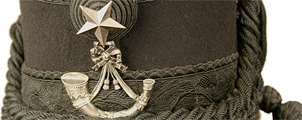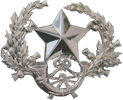C.S.M. Arthur John McMullins
This Cameronian is an example of a soldier that served in the First World War with 1st Battalion, but continued as regular beyond 1918 and is an example of a senior soldier, who remained in the Regiment, in this case with 2nd Battalion, in which he rose to the rank of Company Sergeant Major. His long career came to an abrupt end when he died of encephalitis when with the Battalion in Quetta.


Arthur enlisted on 14th June 1905 and above are the two pages of his record; hand -written, not only showing his times home and abroad, but attestation location and personal details, such as occupation at enlistment, family members, address etc. In other words, a synopsis of a career., You will see his line fifth down on both pages. Unlike other soldiers’ records, there are blank columns in the ‘discharge’ section which would prove a mystery, if we didn’t know that Arthur died while serving abroad, and we can look at that later.
This record shows that McMullins was 18 years and two months old when he signed up. This he did in Stratford in London, and in occupation as a labourer. An interesting point to note is that the Cameronians recruited from far afield and not always locally, as some may think.
This valuable document also records he was married to a Martha Elizabeth Darnell and had three children, living in Shoreditch. The date of the marriage was 2nd August 1914 and it is safe to surmise that they decided to wed before Arthur was sent abroad. We can read that he embarked for France on 14th.
Finally, there are details campaigns, awards and any wounds received. We can list McMullins’ campaigns and times at home:
Home 14/6/05 to 18/9/07
India 19/09/07 to 14/12/09
S Africa 15/12/09 to 11/3/12
Home 12/3/12 to 13/8/14
France 14/8/14 to 10/9/16
Home 11/9/16 to 30/7/18
India 10/19 to 1922
Quetta 1922
Kurdistan/ Bagdad Iraq 1923
Quetta 1924
Arthur John McMullins served with the 1st Battalion in WW1, and published in the London Gazette on 10th October 1916 is the announcement of his award of a Military Medal. Usually, the Gazette entries were published two or three months after the relative action. (It took time for the process of recommendation and signatures). We can safely say that his act of gallantry occurred around July/August 1916. Without being too presumptuous, his brave deed could have been during the 1st Battalion involvement in the battle at High Wood. (Citations for bravery are on record for WW2 awards, but most of the citations relating to WW1 actions were destroyed by fire in the 1940s).
What about MucMullins’ previous career pre-WW1?
We know that he joined up in June 1905 and we know that the 1st Battalion was in India at that time and Arthur must have been sent out in 1907 to spend some time before the battalion left India for South Africa in late 1909. The 1st returned to Scotland in March 1912 ( In the1911 census he shows up travelling back with what would be his brother -in -law Edward Darnell, himself in the 1st) and left for war in France in August 1914. What we can’t explain is why Arthur McMullins was home in September 1916. We know that the 1st Battalion moved into trenches at Foncquevilliers on 11th and was deployed with the attacks on the enemy in October. It may be surmised that McMullins had been wounded in the summer and was sent home to recover. There is no evidence for this, but it seems he had little to contribute to the Battalion for the rest of the war.
Looking at the award for Military Medal, it seems that by that time Arthur was a corporal, with 10-11 years’ service. Compared with many of the men he was serving with, he would have been an experienced member of the battalion.
Lieutenant Colonel Richard Oakley was asked to reform the 2nd Battalion in 1919 as they were wanted for service in India then into Quetta 1922.
In 1923 a rebellion took place against Iraq by Kurdish Sheikh Mahmoud with help from Turkey and, as Britain felt responsible for the independence of Iraq a force was mobilised, and the 2nd Battalion joined an expedition to Kurdistan . An extensive account of this appears in The Covenanter in September 1923. They marched 475 miles to Bagdad by 15th May. Soldiers on this campaign received a KURDISTAN clasp to their General Service Medal.

The Battalion returned to Quetta where they spent the next years. There are quite a few references in the Covenanter to sports and shooting matches. A photograph of the ‘C’ Company 1923 boxing team in Bagdad with what is now Company Sergeant Major A. J. McMullins at the front in uniform. Arthur is regularly mentioned in the Covenanter through the 1920s and had become a popular and important figure in the Battalion.
We have in the collection a selection of caricatures of figures of NCO’s and other ranks from 2nd Battalion in 1927. McMullins is shown top right corner.
Arthur John McMullins died in Quetta of encephalitis, a rare condition of the brain, on 18th October 1927 aged just 40. He is buried in Baleli Road Cemetery, Quetta
In The Covenanter of January 1928
‘We regret to announce the death on the 18th October of C.S.M A, ], M’Mullins, from encephalitis, after serving since 1906 with the Regiment and always being exceptionally fit he was noted cross-country runner in his younger days in South Africa. It is sad that he should have succumbed so soon before his time to go home had come. All ‘ B’ Company mourns a most gallant Sergeant Major, and the sympathy of the whole Battalion is extended to his widow and three children in their loss.’
‘2nd Battalion Notes’ and ‘Sergeant Mess Notes’ the following was written
‘ It is with deep regret that we have to announce the death of our very old friend C.S.M McMullins, who was one of our oldest members. Badly as we may feel his loss, there are others who feel it more so, and it is to them, Mrs. McMullins and her children and relatives to whom we extend our deep sympathy in their bereavement and trust their future burden will be in some way lightened’

Interestingly –from the Covenanter Sept.1928… as a post-script:
C.M.S. McMullins’ eldest son was a pupil of the Queen Victoria School in Dunblane, a school which had, and still does have, links with the Cameronians.

QUEEN VICTORIA SCHOOL. List of boys in above School whose fathers served, or are serving in the Regiment. Bain, J., son of Sergt. A. Bain, 3rd Battalion. Barnes, G., son of C.S.M. G. Barnes. Black, A., son of Pte. A. Black, killed in action, 23/10/16. Brown, J., son of Corpl. J. Brown, 2nd Battalion. Burke, W., son of Sergt. Burke, 1st Battalion., Carroll, W., Carroll, V., sons of Sgt . W. Carroll.. Dunn, V., son of Capt. R. Dunn. . Fyfe, A., son of Pte. A. Fyfe, 2/5th Battalion, died while serving, 3/4/ 1 7. Heron, A., son of Pte. J. Heron, killed in action, 25/9/15. Kitson, W., son of Corpl. A. Kitson. M’Mullins, A., son of C.S.M. A. M’Mullins, 2nd Battalion. Pike, H., Pike R., sons of R.Q.M.S. H. Pike, late 2nd Battalion, Thomson, J., son of Srgt. R. Thomson, 2nd Battalion.
Comments: 0









